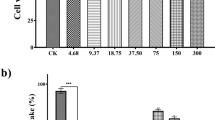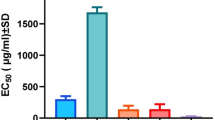Abstract
Bioactivity-guided fractionation of methanol extracts from leaves of Piper auritum produced four triterpenoid saponin compounds 1-4. Structures were established based on interpretation of mass spectrometry (MS), nuclear magnetic resonance (NMR) data. 21-(p-methoxycinnamoyl)-olean-12-ene-28oic cid-3-O-α-L-arabinopyranosyl-(1→2)-β-D-glucopyranoside (1) and olean-12-ene-28 methyl ester-3-O-α-L-arabinofuranosyl-(1→2)-β-D-glucopyranoside (2) were orally administered to diabetic mice at dosage of 10 mg/kg of body weight per day for 30 days and resultant biochemical parameters were studied. Both compounds significantly (p<0.05) decreased serum glucose, total cholesterol, and triglyceride levels, compared with controls. Low density lipoprotein and high density lipoprotein cholesterol levels were ameliorated. The effects of lipid peroxidation and oxidative stress in the liver, pancreas, and kidney were reversed, with reductions insulin resistance and stimulation of insulin production. β-Glucosidase activities were studied in vitro. Compounds 1 and 2 can be used to improve glucose and lipid metabolism and to reduce the imbalance between generation of reactive oxygen species and scavenging enzyme activities for prevention of diabetic complications.
Similar content being viewed by others
References
Fufeng C, Xiong H, Wang J, Ding X, Shu G, Mei Z. Antidiabetic effect of total flavonoids from Sanguis draxonis in type 2 diabetic mice. J. Ethnopharmacol. 149: 729–736 (2013)
Genet S, Kale RK. Baquer NZ. Alterations in antioxidant enzymes and oxidative damage in experimental diabetic rat tissues: Effect of vanadate and fenugreek (Trigonellafoenum graecum). Mol. Cell Biochem. 236: 7–12 (2002)
McKenney JM. Pharmacotherapy of dyslipidemia. Cardiovasc. Drug. Ther. 15: 413–422 (2001)
Malviya N, Jain S. Malvia S. Antidiabetic potential of medicinal plants. Acta Pol. Pharm. 6: 7113–7118 (2010)
Garcia A, Leyva M, Martinez J, Stashenko E. Determination of the composition chemical and antioxidant activity in vitro of essential oil of Piperauritum Kunth (Piperaceae). Sci. Tech. 33: 439–442 (2007)
Perez GRM, Cotera LFC, Neira GAN. Evaluation of the antioxidant and antiglycation effects of the hexane extract from Piper auritum leaves in vitro and beneficial activity on oxidative stress and advanced glycation endproductmediated renal injury in streptozotocin-treated diabetic mice. Molecule. 17: 11897–11919 (2012)
Perez GRM. Effect of the hexane extract of Piper auritum on insulin release from β-cell and oxidative stress in streptozotocin-induced diabetic rat. Pharmacogn. Mag. 8: 308–313 (2012)
Nolis P, Parella T. Spin-edited 2D HSQC-TOCSY experiments for the carbohydrates and peptides. J. Magn. Reson. 176: 15–26 (2005)
Guide Laboratory Animals for the Care and Use of Laboratory Animals. 8th ed. National Academy of Sciences, Washington DC, USA (2011)
Manual Organization of Ethics Committee in Research of the National School of Biological Sciences (CEI-ENCB) del IPN. (1999)
Zhou J, Zhou S, Zeng S, Zhou J, Jiang M, He Y. Hypoglycemic and hypolipidemic effects of ethanolic extract of Mirabilis jalapa L. root on normal and diabetic mice. Evid-Based Compl. Alt. Article ID 257374 (2012)
Trinder P. Determination of blood glucose using an oxidase-peroxidase system with a non-carcinogenic chromogen. J. Clin. Pathol. 22: 158–161 (1969)
Hashimoto S. A new spectrophotometric assay method of xanthine oxidase in crude tissue homogenate. Anal. Biochem. 62: 426–435 (1974)
Erel O. A new automated colorimetric method for measuring total oxidant status. Clin. Biochem. 38: 1103–1111 (2005)
Bradford MA. A rapid and sensitive method for the quantitation of microgram quantities of rotein utilizing the principle of protein-dye binding. Anal. Biochem. 72: 248–254 (1976)
Fraga CG, Leibovitz BE, Tappel AL. Lipid peroxidation measured as thiobarbituric acid-reactive substances in tissue slices: Characterization and comparison with homogenates and microsomes. Free Radical Bio. Med. 4: 155–161 (1998)
Park SE, Cho MH, Lim JK, Kim JS, Kim JH, Kwon DY, Park CS. New colorimetric method for determining the isomerization activity of sucrose isomerase. Biosci. Biotech. Bioch. 71: 583–586 (2007)
Tsujii E, Muroi M, Shiragami N. Nectrisine is a potent inhibitor of α-glucosidases, demonstrating activities similarly at enzyme and cellular levels. Biochem. Bioph. Res. Co. 220: 459–466 (1996)
Conforti F, Statti G, Loizzo MR, Saccherti G, Poli F. In vitro antioxidant effect and inhibition α-amylase of two varieties of Amaranthus caudatus seeds. Biol. Pharm. Bull. 28: 1098–1102 (2005)
Yu L, Haley S, Perret M, Harris J, Wilson J, Qian M. Free radical scavenging properties of wheat extracts. J. Agr. Food Chem. 50: 1619–1624 (2002)
Balavoine GG, Geletii YV. Peroxynitrite scavenging by different antioxidants. Part I: Convenientassay. Nitric Oxide-Biol Ch. 3: 40–54 (1999)
Karadag A, Ozcelik B, Saner S. Review of methods antioxidant capacities. Food Anal. Method. 2: 41–60 (2009)
Re R., Pellegrini N, Proteggente A, Pannala A, Yang M, Rice-Evans C. Antioxidant activity applying an improvement ABTS radical cation decolourization assay. Free Radical Bio. Med. 26: 1232–1237 (1999)
Cao G, Alessio HM, Cutler RG. Oxygen-radical absorbance capacity assay for antioxidant. Free Radical Bio. Med. 14: 303–311 (1993)
Decker EA, Welch B. Role of ferritin as lipid oxidation catalyst in muscle food. J. Agr. Food Chem. 38: 674–677 (1990)
Sreejayan N, Rao MNA. Free radical scavenging activity of curcuminoids. Drug Res. 46: 169–173 (1996)
Fenton R, Chemizmu DK. Fenton reaction-controversy concerning the chemistry. Ecol. Chem. Eng. 16: 347–358 (2009)
Ikuta A, Itokawa H. Triterpenoids Akebia quinata callus tisuue. Phytochemistr. 25: 1625–1628 (1986)
Yoshikawa M, Murakami T, Yoshizumi S, Murakami N, Yamahara J Matsida H. Bioactive saponins and glycosides. V. acylated polyhydroxyolean-12-ene triterpene oligoglycosides, camellia saponins A1, A2, B1, B2, C1, and C2, from the seeds of Camellia japonica L.: Structures and inhibitory activity on alcohol absorption. Chem. Pharm. Bull. 44:1899–1890 (1996)
Takedaa Y, Okada Y, Masuda TC. O-bisglycosylapigenins from the leaves of Rhumnella maequilotera. Phytochemistr. 65: 463–468 (2004)
Qiao A, Wang Y, Xiang L, Zhang Z, He X. Triterpenoids of sour jujube show pronounced inhibitory effect on human tumor cells and antioxidant activity. Fitoterapi. 98: 137–142(2014)
Zhang Z, Koike Z, Zhonghua J, Nikaido T, Guo D, Zheng J. New saponins from the seeds of Aesculus chinensis. Chem. Pharm. Bull. 47: 1515–1520 (1999)
Sharma M, Siddique MW, Shamirn AM, Gyanesh S, Pillai KK. Evaluation of antidiabetic and antioxidant effects of seabuckthom (Hippophae rhamnoides L.) in streptozotocin-nicotinamide induced diabetic rats. Open Conf. Proc. J. 2: 53–58 (2011)
Pepato MT, Migliorini RH, Goldberg A, Kettelhut IC. Role of different proteolytic pathways in degradation of muscle protein from streptozotocindiabetic rats. Am. J. Physiol. 1271: E340–E347 (1996)
Ravi K, Ramachandran B, Subrarnanian S. Effect of Eugenia jambolana seed kernel on antioxidant defense system in streptozotocin-induced diabetes mice. Life Sci. 75: 2717–2731 (2004)
Maghrani, M, Zeggwagh NA, Lemhadri A. Study of the hyperglycemic activity of Fraxinus excelsior and Silybum marianum in an animal model of type 2 diabetes mellitus. J. Ethnopharmacol. 91: 309–316 (2004)
Kim Y, Jeong Y, Wang M, Lee W, Rhee H. Inhibitory effect of pine extract on α-glucosidase activity and postprandial hyperglycemia. Nutritio. 21: 756–761 (2005)
Bolzan AD, Bianchi MS. Genotoxicity of streptozotocin. Mutat. Res. 512: 121–134 (2003)
Yamaji Y, Nakazato Y, Oshirna N, Hayashi M, Saruta T. Oxidative stress induced by iron released from transferrin in low pH peritoneal dialysis solution. Nephrol. Dial. Transpl. 19: 2592–2597 (2004)
Kehrer JP. The Haber-Weiss reaction and mechanisms of toxicity. Toxicolog. 149: 43–50 (2000)
Author information
Authors and Affiliations
Corresponding author
Rights and permissions
About this article
Cite this article
Perez Gutierrez, R.M. Antidiabetic andantioxidant properties, and α-amylase and α-glucosidase inhibition effects of triterpene saponins from Piper auritum . Food Sci Biotechnol 25, 229–239 (2016). https://doi.org/10.1007/s10068-016-0034-6
Received:
Revised:
Accepted:
Published:
Issue Date:
DOI: https://doi.org/10.1007/s10068-016-0034-6




